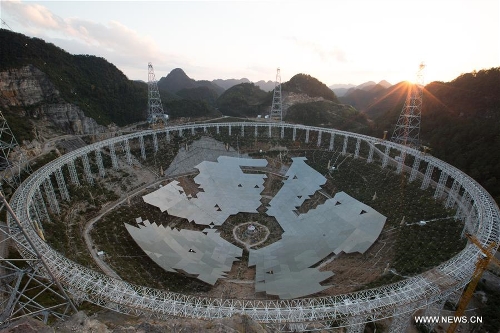cirr
ELITE MEMBER

- Joined
- Jun 28, 2012
- Messages
- 17,049
- Reaction score
- 18
- Country
- Location
google translate
------
Changchun Institute of Optics debut 17th the fair: 2 m-diameter SiC mirror
CAS Changchun Institute of Optics and Fine Mechanics, assistant director with the Institute of Physics Shou Hung on display many of the fine, such as silicon carbide 2 m diameter mirror, which can solve the bottleneck problem of high resolution optical remote sensing space systems, European and American countries to break the long-term monopoly in this field. In addition, there are "fast boat One" load, "One day painting" load, "Chang-e III extreme ultraviolet camera" and so kind.
- 2015/11/17
- Default Category
Large diameter mirror is a high resolution optical remote sensing space system bottlenecks components, and large-diameter high-precision aspheric optics manufacturing technology is the high-resolution remote sensing space, a large-diameter telescopes and other representatives of the country's overall technological level of the large modern optoelectronic devices core and key technologies.
Changchun Institute of Optics based on independent research and development, to complete the preparation of lightweight silicon carbide mirror reflection blank mirror large diameter, large diameter high-efficiency silicon carbide mirror precision machining and inspection technology, large diameter silicon carbide mirror modification and coating technology a series of key technologies, breaking the order of 2m SiC mirror manufacturing technology.
The technology appears to break the monopoly of American and European countries in the field of large-scale telescope technology to meet the needs of major national strategy for the development of large-scale modernization of optoelectronic devices technology provides important support.
---------------------------------------------------------------------------------------------------------------------------
Changchun Institute of Optics wonderful debut 17th the fair
November 16, 2015, the 17th China International Hi-Tech Fair, the "Shenzhen Hi-Tech Fair" 10:00 opening. Changchun Institute of Optics in groups in the form of first-time exhibitors.
Changchun Institute of Optics exhibition area of 300 square meters, set up a "space optical remote sensing", "aviation platforms and equipment", "materials and advanced manufacturing," "precision optical instruments and equipment", "high-power semiconductor lasers," "innovation industry "," journals, international cooperation and exchange, talent introduction "seven theme zones, showing the high performance CMOS image sensor, 2 m-diameter SiC mirror, pointing platform with smart optics, semiconductor lasers, three-dimensional scanning imager, big zoom HD electric telephoto lens total of more than 60 products. Exhibits fully displayed on the Changchun Institute of Optics, "industry-university research simultaneously" road of development with science and technology innovation as the core of acquired research and brand strength.




The same day, led the Chinese Academy of Engineering Zhou Ji, Governor of Guangdong Province, Zhu Xiaodan, CAS Secretary-General Deng came to Changchun Institute of Optics exhibition Mai village, listened to the Changchun Institute of Optics, director Jia Ping made presentations and field watched Achievements demonstration.
Among them, the space remote sensing camera, large diameter optical materials, the world's highest-resolution CMOS image sensor has attracted a number of achievements in scientific research and product from CCTV, Central People's Broadcasting Station, Xinhua News Agency, China News Agency, Economic Daily, Science and Technology Daily, etc. domestic media interest. Special Assistant to the Changchun Institute of Optics, director of Shou-red to the media reporters about the relevant circumstances, and said that the exhibition Changchun Institute of Optics, is hoping this platform, showcasing the long light of recent research results, but also want to research with the other company's products cross-border integration.
On the opening day, many exhibitors came to light long exhibition pavilion to watch the results show, to carry out negotiations.
Shenzhen High-Tech Fair is China's largest and most influential tech exhibition, the exhibition show the full range of the latest achievements of Chinese innovation and development, is an important platform and an important window for China's opening up the field of high-tech high-tech achievements of the transaction, the The exhibition will continue until November 21.
长春光机所亮相第17届高交会:2米口径碳化硅反射镜 - China Spaceflight
The world's largest 2-metre diameter silicon carbide(SiC)mirror













